





Today?s hybridizing techniques are taking watermelon to a new high for nutrition and health. Fresh watermelon is still available, so don?t miss out on its summertime flavor and nutritional benefits. Learn from watermelon growers on how to grow the many varieties of this super fruit in your own garden.
(Editor's Note: This article was originally published on August 20, 2008.)
Watermelon is a member of the cucumber (Cucurbits) family. It is a native plant of the Kalahari Desert in Africa and can grow under extreme UV radiation, high heat and drought; it has evolved as a melon full of free radical fighting power. Watermelon is used in cosmetics and toiletries for skin protection; and it is a very healthy fruit to include in your diet.
On a recent stop to a farm stand, owner Chris Chiaccio, of Tony's Farm & Garden Center in Windsor, NJ commented,
"I feel better when I eat watermelon."
She may feel better from eating watermelon for 3 reasons:
1) Watermelon is 90% water; it is hydrating and makes us feel refreshed
2) Watermelon has energy-yielding natural sugars
3) Watermelon contains vitamins, minerals and other compounds
Watermelon is low calorie. A one cup serving is only 46 calories.[1] Like most fruit, watermelon is fat-free and has no cholesterol. Watermelon has a lot more than just water and sugars in it.
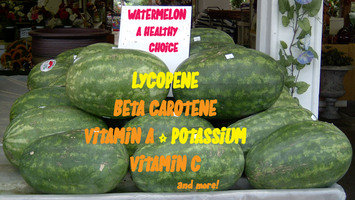 Did You Know?
Did You Know?
Watermelon contains health-promoting nutrients, such as vitamin A, potassium, citrulline; and beneficial antioxidants, such as lycopene, beta carotene and vitamin C.
Antioxidants have disease fighting properties that may help prevent cancer and reduce heart risks. [2]
Citrulline is a potential antioxidant that helps maintain blood flow [3] and heart health.
Nutrition Information [4]
Watermelon per 100 grams (about 8 melon balls)
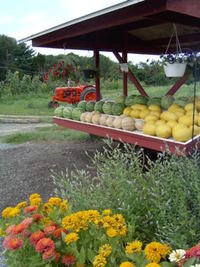
Varieties of Watermelon
There are many varieties of watermelon grown in the U.S. and they vary by state. California farmers primarily grow 'Fiesta', 'Laurel', 'Nova', 'Sangria', and Wonderland. In Florida you might find 'Dillon', Ecstasy, 'Freedom', 'Genesis' and 'Mohican'. In the Texas high plains, farmers primarily grow 'Allsweet' and 'Jubilee'.[5] Dave's Gardeners have grown varieties that include: 'Raspa', 'Triton', 'Matador', 'Emperor', 'Pinata' and 'Schochler'. Visit PlantFiles here on Dave's Garden to discover even more watermelon varieties.
Growing Watermelons
In General
Watermelons require a long growing season--about 3 months from planting to harvest--and need warm soil temperatures and full sun. The vines are rambling, and in most varieties the fruits are fairly large. The vines can easily spread 6 to 8 feet in their first month. After a few months blossoms appear, then baby melons. When the melons are ripe, they have a light, yellowish area touching the ground and their tendrils are longer and less green. They are then ready to be hand-picked.
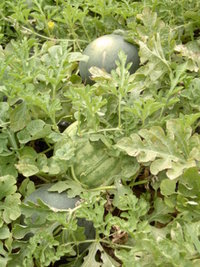 Seedless Watermelons
Seedless Watermelons
Growing seedless watermelons require an extra step, but it is by no means difficult. Start with fresh seed; the seed is only good for a year. [6] To grow seedless watermelons, a second type of melon with seeds has to be planted in the same area. The second melon is considered the pollinizer and should be something that is noticeably different from your seedless variety, such as a smaller size or a solid color. For example, farmer Ray Hlubik (pronounced Lubik) of Hlubik Farms in Chesterfield, NJ uses 2 different pollinizers in a 1/2-acre patch containing several seedless varieties. His pollinizers, which make up about 25% of his crop, include a solid green 'Sugar Baby' type and also a very small watermelon that won't compete for growing space with his seedless melons.
Seedless watermelons are a result of a crossing traditional, diploid, seeded melons with tetraploid melons. The result is a hybrid, seedless, triploid species. This simply means that the numbers of chromosomes are different, and genetically the seedless melon will be sterile. The seedless will still get flowers, but will need help in pollination from a nearby diploid pollinizer. Honeybees are the key for a successful watermelon crop, since the pollen in watermelon blossoms is heavy and sticky and requires more than just the wind to transfer it from flower to flower.
Growing watermelon in a small garden
When there is a will, there is a way! Thanks to the many varieties of melons available, selecting a smaller-sized melon may work for your small garden area. Some people have even grown watermelon off their high rise balconies successfully! In small garden situations the melon vines can be trellised and the fruit can be harnessed with expandable netting or pantyhose. This technique can also be done with other climbers that bear heavy fruit or vegetables.
Watermelon Pests and Diseases
Back in 1989 a disease called bacterial fruit blotch, carried in the seed, wiped out many watermelon crops. It is still a concern for today's growers. Control measures are being taken by seed companies and some even require that their customers sign a waiver before purchasing watermelon seeds. This is done as to protect against lawsuits from the farmers, should financial losses result from crop failures.
Dave's Garden member and watermelon grower "Farmerdill" from Augusta, Georgia says striped cucumber beetles are a major pest and soil-borne diseases, like fusarium wilt, can be a problem if your cultivar is not resistant to it. Other pests Farmerdill cautions about include deer, raccoons, and crows.
Gardening Tips from Growers
Preparation
Watermelon is so easy to prepare...just wash, cut and eat! Don't forget to wash your fruit, to remove any surface bacteria. Watermelon can be cut into wedges, cut in half with a zig-zag pattern for a decorative basket to use for fruit salad, or the pulp inside can be scooped out for use in recipes. 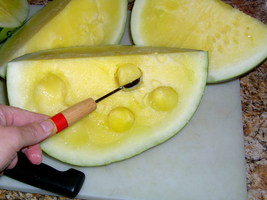
Watermelon Recipe Ideas
An easy recipe for melons is to cut them into bite-size cubes or scooped into rounds with a melon baller for fruit salads or fruit kabobs. The pulp (remove seeds first) can be put in a food processor or blender for quick and easy smoothies or watermelon juice. Melon pulp can also be frozen for later use in beverages or soups.
Watermelon Soup: Remove seeds and puree the pulp, using the amount you want (optional: strawberries, bananas or other melon can also be added.) Add fruit juice of any kind to desired consistency and chill. Garnish with whipped cream thinned out to the same consistency, swirled on the top! All ages love watermelon as a healthy snack or dessert 

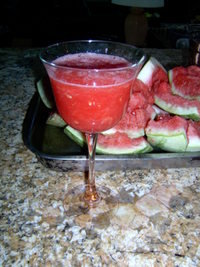
watermelon rind
pickled, stewed or fried
For Further Reading: "I Grew This" by Benjamin Hill
Footnotes: photos ©Wind, 2008
[1] Nutrition Data, Nutrition Facts and Analysis for raw Watermelon; Accessed July 22, 2008.
[2] American Dietetic Association; Lycopene: an Antioxidant for Good Health; http://www.eatright.org Accessed Aug. 8, 2008.
[3] Rimando A, Perkins-Veazie P, Determination of Citrulline in Watermelon Rind; Journal of Chromatography A. 2005; 1078:196-200.
[4] USDA National Nutrient Database for Standard Reference, Release 20 (2007), Raw Watermelon; Accessed Aug. 5, 2008.
[5] USDA, National Agricultural Statistics Service, Table 33-US watermelon, fresh: Growing areas and principal varieties; http://www.nass.usda.gov. Accessed Aug. 5, 2008.
[6] Starling L, Seedless Watermelons, Virginia Cooperative Extension. Accessed Aug. 12, 2008.
Copyright © www.100flowers.win Botanic Garden All Rights Reserved